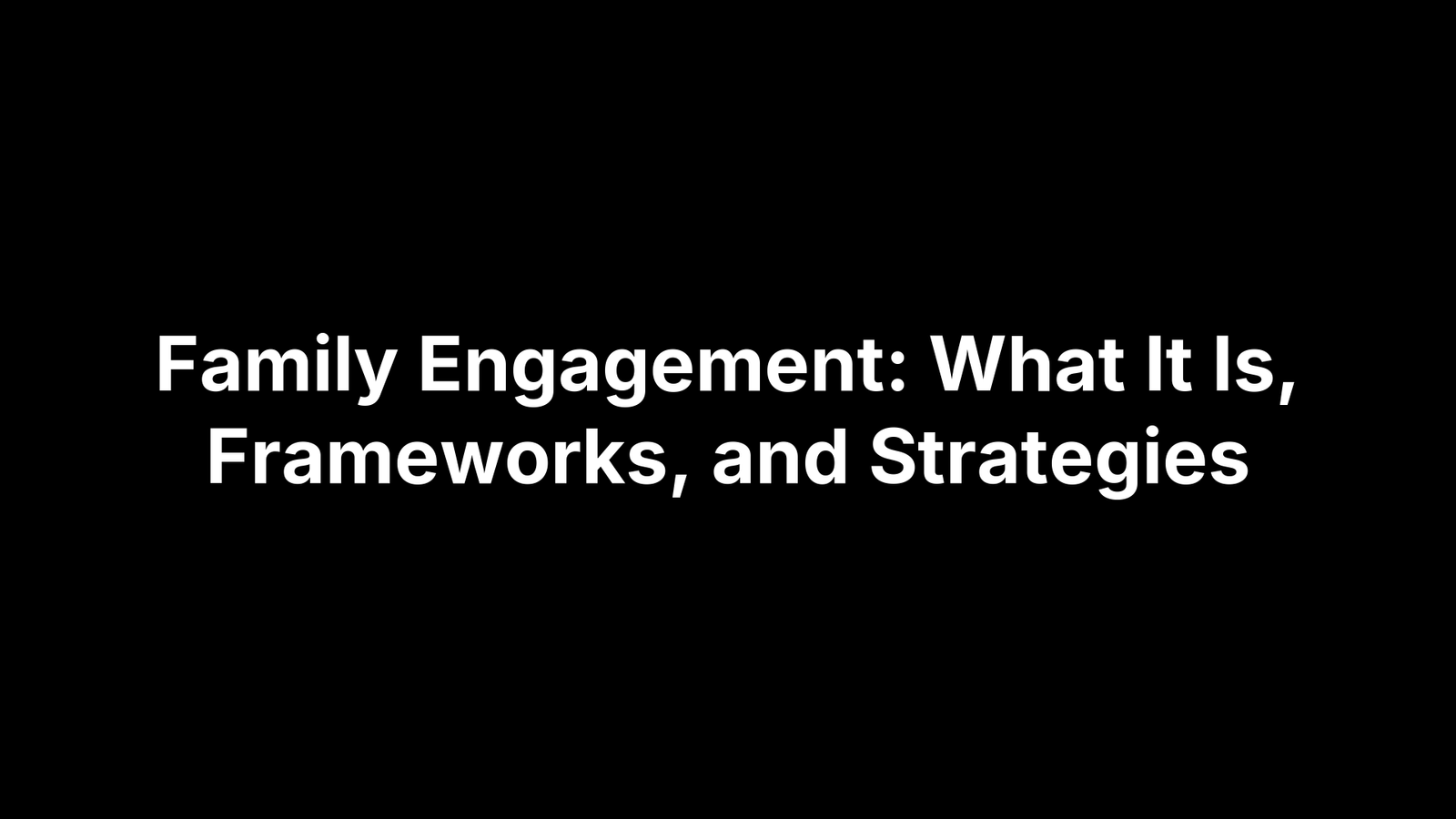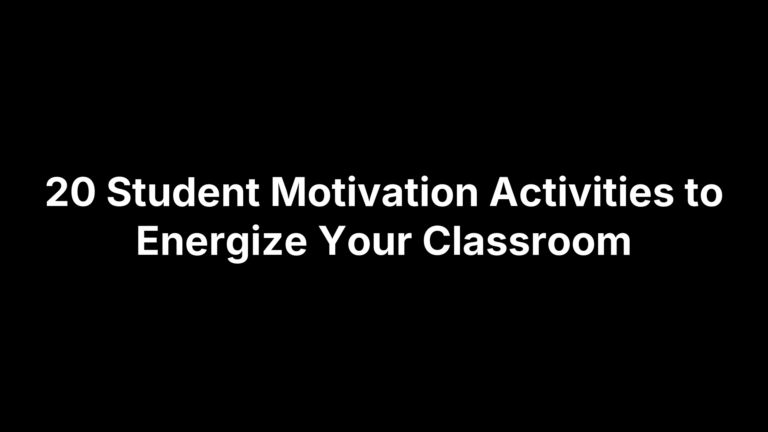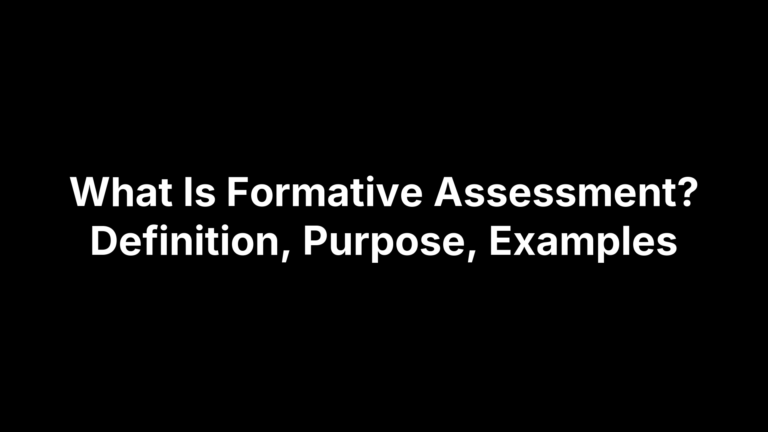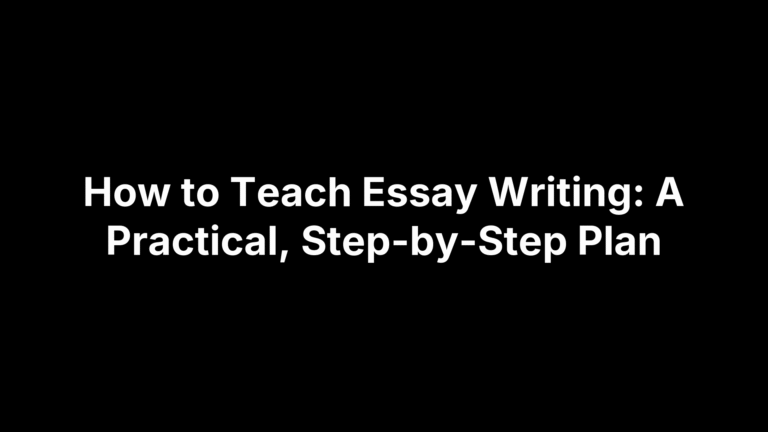Family Engagement: What It Is, Frameworks, and Strategies
Family engagement is a true partnership between educators and the important adults in a child’s life—parents, grandparents, foster caregivers, and others—to support learning and well‑being. It’s strengths‑based, culturally and linguistically responsive, and built on ongoing, two‑way communication. Rather than a one‑time event or a sign‑in sheet, engagement means listening, sharing information, setting goals together, and reinforcing learning across home, school, and community as children grow and family roles evolve.
This article defines family engagement in plain language and shows how to make it work in real classrooms. You’ll find why it matters, how it differs from “involvement,” and field‑tested frameworks you can use (Head Start PFCE, NAFSCE). We cover equity practices, high‑impact strategies by setting and age, communication that builds trust, using data to improve, building staff capacity, and ethical ways to leverage technology and AI—plus common pitfalls, solutions, and a 90‑day action plan with ready‑to‑use templates. First up: why engagement drives learning and well‑being.
Why family engagement matters for learning and well-being
When schools and families work as true partners, children benefit across development and academics. Research highlighted by the U.S. Department of Education and Head Start connects effective family engagement to healthy development, school readiness, and overall well‑being. The ongoing parent–child relationship is honored and strengthened, and educators gain insights that improve instruction and support. As trust grows, communication becomes more two‑way and goal‑oriented, reinforcing learning at home, in classrooms, and in community settings. The result is shared responsibility for student success and more resilient school communities.
Core principles and how engagement differs from involvement
At its core, family engagement is a strengths‑based, shared responsibility built on mutual respect and continuous two‑way communication. It is culturally and linguistically responsive, honors the parent–child relationship, and is goal‑oriented across home, school, and community. Engagement asks staff and families to co‑plan, share data, and sustain learning partnerships as children grow.
- Involvement = school‑directed participation; engagement = co‑creation and shared decisions.
- Involvement centers on events; engagement centers on goals and student outcomes.
- Involvement is one‑way updates; engagement is reciprocal listening and data sharing.
- Involvement values time given; engagement values family expertise, culture, and assets.
Guiding frameworks you can use (Head Start PFCE, NAFSCE)
Two widely used guides can anchor your family engagement plan. The Office of Head Start’s Parent, Family, and Community Engagement (PFCE) Framework is a road map for building strengths‑based, goal‑oriented partnerships that promote family well‑being, healthy development, and school readiness. NAFSCE endorses a definition that stresses shared responsibility across a child’s life and across settings—home, school, and community.
- Head Start PFCE Framework: Structure partnerships, center culturally and linguistically responsive practices, and use data with families to support progress.
- NAFSCE definition and high‑impact engagement: Focus on collaborative, culturally competent, learning‑focused strategies—home visits or community walks, sharing student data, modeling practices for home, listening and integrating family culture, and aligning with school goals.
Equity and access: culturally and linguistically responsive practices
Equity in family engagement means removing barriers and designing partnerships that reflect families’ languages, cultures, and capacities. Head Start centers culturally and linguistically responsive relationship‑building, and NAFSCE calls for culturally competent collaboration across settings. In practice, every family can access, understand, and shape learning—regardless of language, schedule, or ability.
- Home‑language communication: Use qualified interpreters for two‑way dialogue.
- Flexible formats: In‑person, phone, text, and virtual conferences.
- Accessible information: Plain‑language materials; support caregivers with disabilities.
- Community connection: Community walks and home visits to build trust.
- Cultural integration: Bring home cultures into lessons and school events.
- Relational practices: Use sustained conversations (pláticas) to surface strengths and goals.
High-impact strategies across settings: home, school, and community
High‑impact family engagement spans home, school, and community. NAFSCE stresses collaborative, culturally competent, learning‑focused moves—combined for bigger gains.
Home
At home, coach and build on family strengths.
- Model practices at home: Demonstrate reading, talk, and problem‑solving routines families can use.
- Share and use data: Provide clear skill snapshots and co‑create simple, goal‑linked activities.
School
In school, turn every contact into a co‑learning moment.
- Listen to differentiate: Use family insights about interests and challenges to adjust instruction.
- Integrate culture and align: Bring home cultures into lessons and connect efforts to school goals.
Community
Extend engagement into afterschool, libraries, and faith‑based spaces.
- Meet families where they are: Home visits and community walks build trust and understanding.
- Leverage local partners: Afterschool, libraries, faith‑based groups, and father‑focused networks reinforce learning.
Age-appropriate approaches: early childhood through high school
Family engagement should evolve with students’ development. Guided by PFCE and NAFSCE, roles shift from direct guidance in early childhood to coaching and shared decision-making in adolescence. Keep the throughline the same: reciprocal communication, culturally and linguistically responsive practices, and learning goals reinforced across home, school, and community.
- Early childhood: Build trust through home visits and sustained conversations (pláticas); model play‑based routines; communicate in families’ home languages.
- Elementary: Share clear skill snapshots; model simple at‑home literacy/numeracy practices; integrate families’ cultures into classwork.
- Middle school: Co‑set goals tied to everyday attendance and learning habits; use two‑way updates to adjust instruction.
- High school: Share progress and pathways; connect families with community partners and afterschool supports; elevate student voice with family coaching.
Communication that builds partnership: two-way, data-informed, goal-oriented
Communication that fuels partnership is reciprocal, timely, and anchored in student learning. In effective family engagement, educators invite dialogue, translate into home languages, and turn data into plain-language snapshots with what-to-do-next. Conversations start with strengths, end with a clear goal, and document who will do what, when—while honoring privacy requirements (e.g., FERPA) and preferred communication modes.
- Two-way channels: offer text, phone, in-person, and virtual; always include a response prompt.
- Data made useful: share brief skill snapshots plus one or two actionable home routines.
- Goal-oriented cadence: set a date to check progress and adjust together.
Using data to measure progress and improve practice
Use data with families—not on them—to guide decisions, celebrate wins, and adjust support. The Head Start PFCE approach emphasizes using data to support family and program progress; share plain‑language snapshots, co‑set targets, and check in together. Keep measures practical, actionable, and respectful of privacy and FERPA. Start small: choose a few indicators, review them on a schedule, and refine your family engagement practices based on what you learn.
- Leading indicators: everyday attendance, response rates to two‑way messages, timely progress checks.
- Learning indicators: skill snapshots tied to readiness or course standards.
- Partnership indicators: home‑language access, participation quality notes, family feedback.
- Outcome indicators: progress toward co‑created goals and next steps.
Building staff capacity: relationship-based competencies and training
Building staff capacity is the engine of sustainable family engagement. The Head Start PFCE approach and its relationship‑based competencies guide what adults must know and do: build strengths‑based, culturally and linguistically responsive partnerships, use data with families, and connect community supports. Prioritize job‑embedded practice—modeling, observation, feedback—and reflective supervision to turn skills into daily habits.
- Culturally responsive talk: interpreters, plain language, sustained conversations (pláticas).
- Goal‑oriented partnership: home visits/community walks; co‑create and revisit goals.
- Data with families: skill snapshots, action steps, FERPA basics.
- Inclusive engagement: fathers, disabled caregivers, and families of children with disabilities.
Leveraging technology and AI to scale family engagement ethically
Technology can widen access and make family engagement consistent—without replacing relationships. Use secure, multilingual channels to sustain two‑way updates; automate attendance or goal reminders; and use AI to translate, turn data into plain‑language snapshots, and suggest home activities aligned with class goals.
- Consent and privacy: FERPA-aware, opt‑in, collect only what’s needed.
- Human-in-the-loop: staff review translations, tone, and next steps.
- Bias checks: routinely audit prompts, data, and outputs.
- Accessibility and choice: WCAG supports; offer low‑tech, home‑language options.
Common challenges and practical ways to overcome them
Even strong family engagement plans face predictable roadblocks—time, language, trust, tech, and data use. Address them upfront with strengths‑based, culturally and linguistically responsive routines so partnerships stay focused on shared goals and students experience consistent support across home, school, and community.
- Time/schedules: Flexible times, virtual options, brief check‑ins.
- Language/accessibility: Qualified interpreters, home‑language messages, plain language.
- Trust/history: Lead with listening, home visits/community walks, pláticas.
- Data overload: Share short skill snapshots plus one next step.
- Tech/inclusion: Low‑tech choices; proactively invite fathers and disabled caregivers.
A 90-day action plan and ready-to-use templates
Use this PFCE- and NAFSCE-aligned 90-day sprint to stand up a strengths-based, culturally and linguistically responsive family engagement system. Keep communication two-way, data-informed, and goal-oriented, and protect privacy with FERPA-aware routines. Center mutual respect and shared responsibility in every step, and document who will do what, by when.
- Days 1–30: Map touchpoints, set home-language channels, pilot plain-language skill snapshots, pick three indicators.
- Days 31–60: Co-create family goals, model at-home routines tied to snapshots, set a check-in cadence.
- Days 61–90: Review data with families, adjust and scale what works, codify workflows and templates for continuity.
Ready-to-use templates
Copy and adapt these plain-language, two-way tools:
- Family strengths and goal form
- Skill snapshot + next-step card
- Two-way message script with response prompt
Next steps
You now have a clear definition, frameworks (PFCE, NAFSCE), equity lens, age-appropriate strategies, two-way communication routines, data practices, capacity builders, and a 90-day plan. Choose one class or grade team, pick three indicators, and run the sprint. Celebrate quick wins, then scale. If you want ready-made templates, checklists, and AI helpers for messages, snapshots, and goals, explore The Cautiously Optimistic Teacher and grab the weekly roundup. Your next move starts with one two-way conversation that names a strength, sets a goal, and schedules the follow-up.







